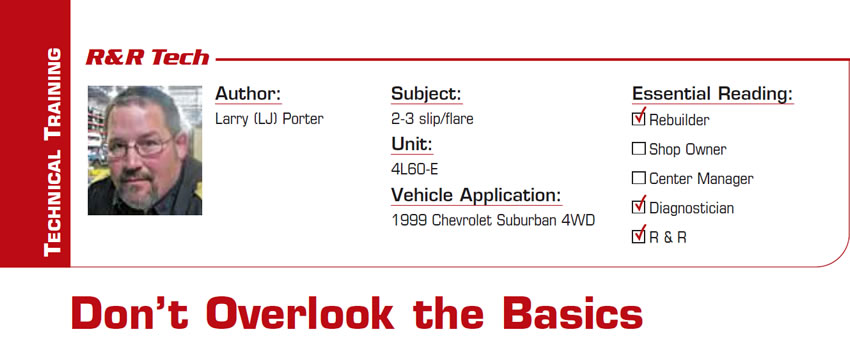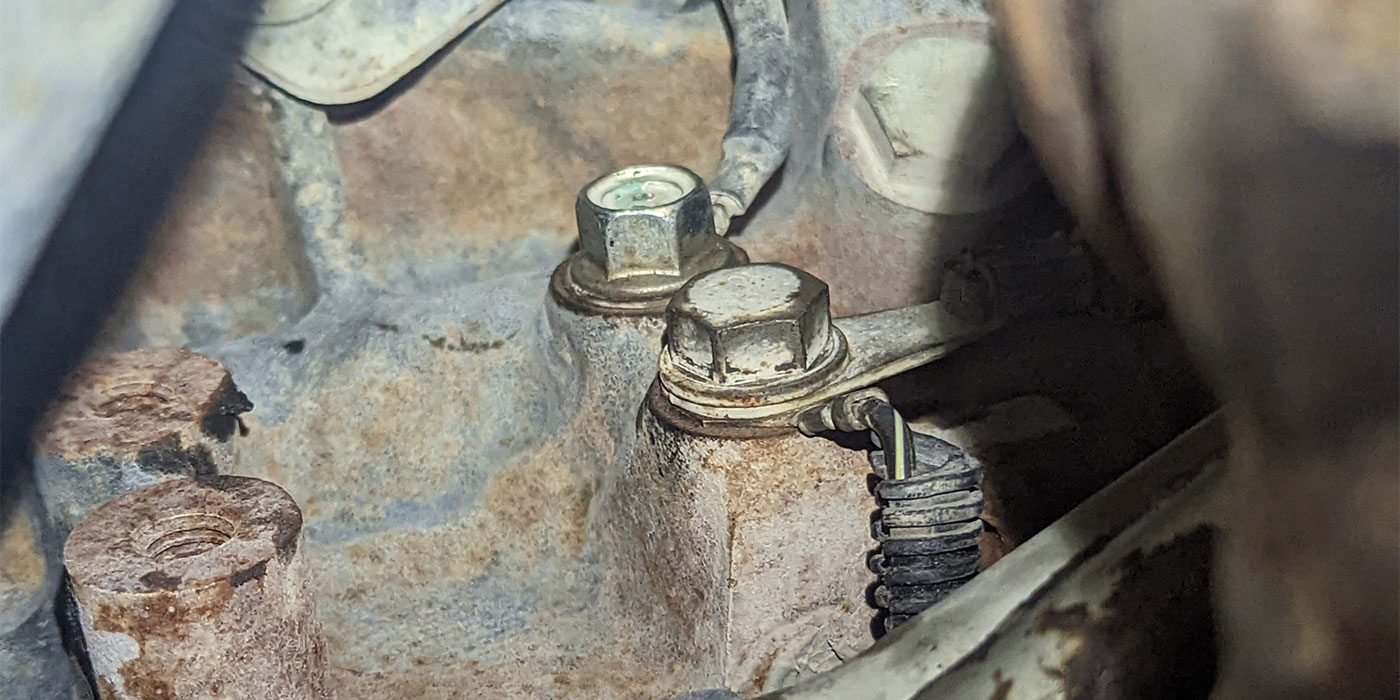
R&R Tech
- Subject: 2-3 slip/flare
- Unit: 4L60-E
- Vehicle Application: 1999 Chevrolet Suburban 4WD
- Essential Reading: Rebuilder, Diagnostician, R & R
- Author: Larry (LJ) Porter
Our carry-out customer was working with a 1999 Chevrolet Suburban 4WD equipped with a 4L60-E transmission. Their technician was able to re-create a slip/flare condition on the 2-3 shift. The fluid was full but a little burnt. A quick hookup of the scan tool revealed no codes existing in the system. Pressure gauges were attached for testing and indicated around 75 psi at idle, and 125 psi at the half throttle position.
Watching the parameter identification data (PID) during the road test indicated that the PCM was commanding each shift properly, but the unit was sluggish to respond on the 2-3 shift. There was nothing that would indicate an electrical-control or sensor-input issue, so the shop ordered a remanufactured unit from us and installed it the next day.
Shortly after the installation, our warranty department received a call from the shop with the same complaint as experienced with the original transmission. After receiving the information from the shop about the problem, we decided it would be best to bring this vehicle back to our own shop, because the installer was nearly positive that the issue was inside the unit we built. Things weren’t adding up, and we figured that it would be a disservice to both our customer and his if we simply sent a warranty replacement as he was asking us to do.
Once I gained possession of the vehicle, I road-tested it and found that there was indeed a slip on the 2-3 shift. The installing shop had reported that the shift quality was better since the replacement unit was installed but the slip was still there. A code scan showed no codes, and all pressures were normal. No warning lights were illuminated, either. I decided to take the vehicle on the road to see what the PID might tell me.
Everything on the PID screen appeared normal, with one exception: The 2-3 shift was occurring about five seconds after the PID showed third gear commanded on by the PCM. Since I had no codes to indicate that there was anything I should be concerned about electrically, I decided to check some of the hardware first.
The first thing I did was pull the 2/4-band servo for inspection. This servo applies the band in second gear and releases for third gear, so if it wasn’t releasing properly it could cause a delayed shift or other shift abnormalities. The servo checked out just fine, so I pulled the pan to make sure everything was clean and also to take a look at the solenoids. Visually, everything appeared to be in perfect condition. Not sure about what to do next, I determined that I would have to test the electrical integrity of the solenoids and wiring, as there wasn’t much left to check.
Individual resistance checks of the solenoids proved that they were all within specification. Additionally, all the wiring between the PCM and the main transmission connector showed no opens, shorts or high resistance. I expected these results, because there were no codes indicating any electrical issues. Usually the PCM is quick to flag these items if there is any fault – back to square one.

I re-checked all the chassis and engine grounds, and all the power feeds to the transmission and PCM. There was nothing to indicate a problem in any of these areas. I checked the PCM-calibration revision and found that there was an update available, so in desperation I decided to reflash the PCM to the latest available software. A quick road test afterward was discouraging; the issue was still there.
At this point I was convinced that the issue was somewhere on the vehicle and not inside the transmission. There was something I was missing, but what could it be? I began to think about everything I had learned in my years as a diagnostician and some of the odd things that I could remember about the characteristics of electricity that instructors had taught me in the past. It was then that I remembered something that the books don’t always have you check, and something that the ohmmeter won’t always catch: the ability of a circuit to carry electrical load.
I believed that my focus should be on the solenoid circuits. A crude, yet effective, way I had learned to test the ability of a circuit to carry a load was to use an ordinary 12-volt light bulb wired in series with the circuit being tested. Anything less than full brightness would indicate a potential fault. The only thing that made me skeptical was the fact that both shift solenoids are commanded off in third gear, so a problem in the circuit itself seemed unlikely. I wanted to check the circuits anyway.
A forced ground on each circuit with the PCM disconnected showed a full, bright light on all of them, and that proved that the wiring and solenoids themselves were in fact capable of supporting the proper electrical load. Next, I needed to reconnect the PCM and manually make the shift commands with the scan tool to see whether the PCM drivers also had the ability to carry the load. It was this test that finally revealed a fault that I needed to look at.
Although each of the circuits I tested produced a full, bright light, the test revealed something really odd: When third gear was commanded it took nearly five seconds before the ground for the 2-3 shift solenoid was turned off (as commanded) by the PCM. I also noted that the light “faded” to dark instead of immediately going off. Aha! Somehow the PCM wasn’t releasing the ground immediately when commanded to do so, and this made perfect sense in regard to the delay and slip condition of the unit, since we weren’t releasing second gear in a timely and smooth fashion.
I’m no engineer, so I wasn’t really interested in knowing what was actually happening inside the PCM; I just knew that what it was doing was wrong. I also knew that no input I was aware of could cause this condition, so I ordered a replacement PCM and installed it.
Monitoring the PID again on the final road test showed that the shifts were occurring exactly when commanded, and the 2-3 slip/flare was gone. The truck was now ready to go back to our customer.
Scan tools are great for telling us what the PCM sees for input values, but they can’t always detect or tell us what the outputs are doing. There are many diagnostic tools available for a technician to buy, but they are no substitute for a technician’s ability. In the end, sometimes instinct, common sense and some crude test equipment are all we need to make those pesky diagnostic nightmares disappear and get the vehicle back to a pleased customer.

Larry Porter has been with Certified Transmissions for 20 years. He is the lead diagnostician at Certified’s Maple Street store in Omaha, Neb.













